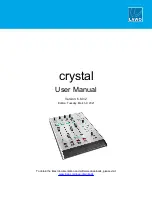
Safety
English
9
Guard function
a)
Check the guard for proper closing before each
use. Do not operate the saw if the guard does not
move freely and enclose the blade instantly. Never
clamp or tie the guard so that the blade is exposed.
If the saw is accidentally dropped, the guard may be
bent. Check to make sure it moves freely and does not
touch the blade or any other part, in all angles and
depths of cut.
b)
Check the operation of the guard spring. If the
guard and the spring are not operating properly,
they must be serviced before use.
The guard may
operate sluggishly due to damaged parts, gummy
deposits, or a build-up of debris.
c)
Assure that the base plate of the saw will not
shift while performing a “plunge cut”.
Blade shifting
sideways will cause binding and likely kick back.
d)
Always observe that the guard is covering the
blade before placing the saw down on bench or
floor.
An unprotected, coasting blade will cause the
saw to walk backwards, cutting whatever is in its path.
Be aware of the time it takes for the blade to stop after
the switch is released.
The pipe saw must never be used in the
following cases:
There is water or another liquid, explosive gases, or
poisonous chemicals inside the pipe to be cut.
The power switch is faulty.
The power cable is faulty.
The blade is bent.
The blade is dull or in poor condition.
The plastic components are cracked or have parts
missing.
The blade guard cover or moving blade guard has
been damaged or removed from the machine.
The locking mechanisms do not work properly
(UNLOCK - SWITCH).
The pipe saw has become wet.
When you use the saw, the following factors
shall be considered:
Support the pipes to be cut properly so that the
blade is not clamped between the ends of the pipes.
Support the pipe to cut securely. Pipe supports are
more reliable for holding the pipe than bare hands.
Make sure that the pipe to be cut is empty. Take
care that no-one will put anything inside the pipe
during the operation.
Make sure that the diameter and thickness of the
blade is suitable for the saw and that the blade is
suitable for rotational speed selected
Do not use damaged or faulty blades or blade
flanges. Blade flanges and nuts are custom made
for this tool to ensure optimum operating
performance and safety.
Never use axial friction force to stop the blade, let it
stop freely.
Check the parts of the blade protection, never
operate the tool if blade covers are not in place.
Never apply excessive force when using the
pipecut.
Never use the pipecut to lift the pipe when fixed on
the pipe.
Avoid excessive load on the electric motor.
Always wear a dust mask if cutting materials that
produce dust, for example cast iron with Diamond
blade.
Always follow safety and operation manual and
applicable regulations.
Intended Use
PipeCut Infinity
PipeCut Infinity pipe saw is intended for use as a pipe
fitter’s tool at the job site.
PipeCut Infinity can only be used to cut round pipes,
with a diameter of
460mm – 3000mm (18"– 120")
PipeCut Infinity can be used to cut pipes with greater
diameter if additional chain sections are used. Chain
delivered with the PipeCut Infinity works on pipes with
diameter up to 1850mm.
Maximum wall thicknesses:
Steel
20 mm (0,78") 230V / 0.5” (12mm) 120V
Plastic 50 mm (2.0")
PipeCut Infinity pipe saw can be used to cut all normal
pipe materials, such as steel, stainless steel,
cast/ductile iron, copper, aluminum and plastic. When
cutting different materials, always use appropriate
blade.
See the cutting depth table on back cover.
PipeCut Infinity pipe saw is not intended for use in
industrial production.
Use only blades within the diameter range stated in
technical data.
Do not use any abrasive wheels.
Do not use any blade with lower speed marking than
no-load speed marked on the power tool.
Use pipe holders to support the pipe being cut.
Summary of Contents for PipeCut Infinity
Page 2: ...Intentionally left blank...






































